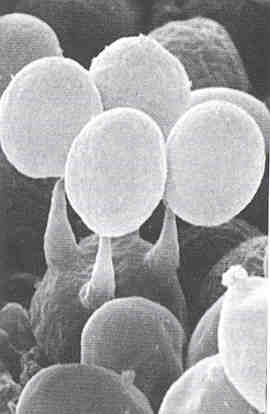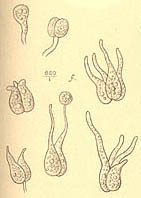
Phylum Basidiomycota - "The Basidiomycetes" - REFER TO CHAPTER 6 IN THE TEXTBOOK.
- septate hyphae, often with clamp connections present
- multicellular sporocarp called the basidioma or basidiocarp is common
- sexual spores (basidiospores) produced over a hymenium on the surface of club-shaped structures (basidium) at the tip of sterigma (pl. = sterigmata)
- some groups have a HOLOBASIDIUM (a single-celled basidium), while others possess a PHRAGMOBASIDIUM (a basidium that is divided into more than one cell by transverse or longitudinal setpa.
- very diverse groups (from some types of yeasts, to rust and smut fungi, gilled-mushrooms, puffballs, polypores, etc.)
- Spore discharge - see http://www.anbg.gov.au/fungi/spore-discharge-mushrooms.html
- The following figures arefrom http://www.uleth.ca/bio/bio1020/images/copb2.jpg and http://www.ilmyco.gen.chicago.il.us/Terms/basid133.html and http://www.paddenstoel.nl/html/basidien.html

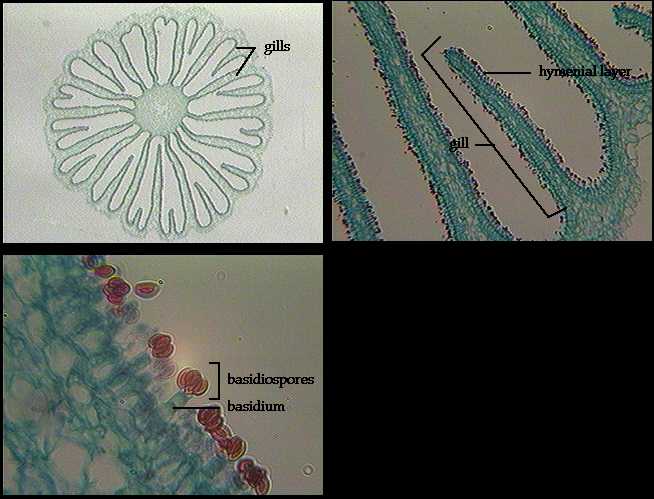
TWO BASIDUM TYPES
HOLOBASIDIA PHRAGOMOBASIDIA
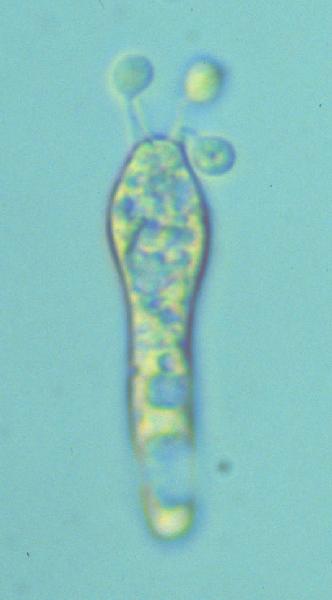
OTHER EXAMPLES OF HOLOBASIDIA AND PHRAGMOBASIDIA
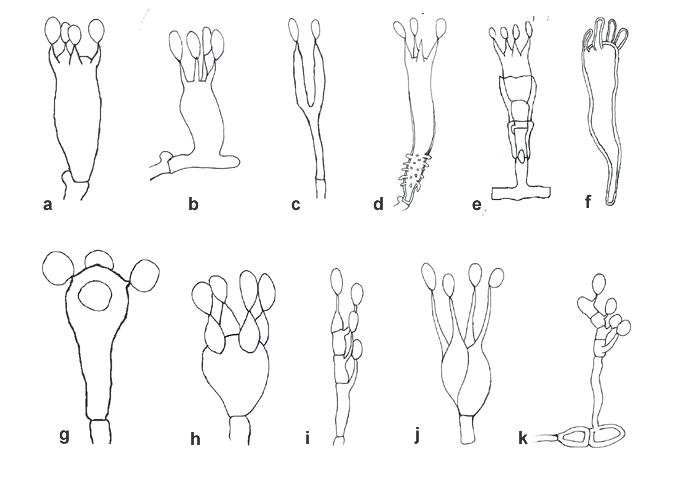
The formation of a clamp connection and maintenance of the dikaryon in
a basidiomycete.
Within the Phylum Basidiomycota there are three major classes Refer to specimens and material available in the laboratory for further information:
- Class Uredinoiomycetes
- Class Ustomycetes - The Smuts
- Class Basidiomycetes
- Order Tremellales- jelly fungi; Tremella mesenterica - witch's butter
- Order Auriculariales - fungus ears; Auricularia auricula - wood ear
- Order Aphyllophorales - chanterelles, tooth fungi, polypores, coral fungi.
- Order Agaricales - the boletes, gilled mushrooms - inky caps, oyster mushrooms, etc.
- The following
orders were formerly placed in the FORM CLASS Gasteromycetes or "stomach
fungi".
- Order Phallales - stinkhorns (picture 1; picture 2)
- Order Lycoperdales-
puffballs
(on link puffballs are seen toward top of web page) and earth stars
- PUFFBALL ARTICLE: PAGE 1; PAGE 2
- TOM VOLK'S FUNGI: FUN WITH A GIANT PUFFBALL
- Order Tulostomatales- stalked puffballs
- Order Sclerodermatales - earth balls (on link earthballs are seen toward bottom of web page)
- Order Nidulariales - bird's nest fungi and sphere throwers
- OTHER ORDERS INCLUDED IN THE CLASS BASIDIOMYCETES BUT NOT COVERED
IN CLASS:
- Order Septobasidiales
- Order Brachybasidiales
- Order Dacrymycetales
- Order Tulasnellales
- Order Melanogastrales
- Order Gauieriales
Mycophagy - To eat or not to eat?
MYCOPHAGY - (Gr. mykes = mushroom + phagein = to eat) is a practice that dates back to antiquity. Edible mushrooms are good sources of protein (by dry weight), indigestible "fiber" (due to presence of chitin), some potential medicinal compounds, and add diversity to our omnivorous diet (e.g., true morels, oyster mushrooms, button mushrooms, shiitake). Mushrooms include the sporocarps of certain members of the Phyla Ascomycota and Basidiomycota.
|
|
THE CULTIVATION, COOKING, AND MYCOPHAGY OF OF THE OYSTER MUSHROOM: PLEURTOUS OSTREATUS |
|
|
|
|
|
|
|
|
|
Mushroom Cultivation - for food and medicinal purposes.
-
Examples of some of the fungi under cultivation:
- Lentinus (Lentinula) edodes - Shiitake [Tom and Brandy Kimmons, Shirley, AR ].
- Volvariella volvacea - the padi straw mushroom
- Pleurotus ostreatus - oyster mushroom [cultivated on straw in lab, courtesy FUNGI PERFECTI, cooked in butter or olive oil, and eaten - delicious!]
- Flammulina velutipes - enoke or winter mushroom
- Auricularia polytricha or A. auricularia - ear fungus
- Ganoderma lucidum - reishi mushroom
- Morchella esculenta and other related species. the morel
- Tuber melanosporum and other Tuber species - truffles
- Dictyophora indusiata - stinkhorns
- Coprinus comatus - the shaggy mane (an edible inky cap mushroom)
- Agaricus brunnescens or A. bisporus (homothallic -
sexual compatiblity is built in), A. bitorquis and related
species - meadow or brown or crimini, portabella, or button mushrooms
(cultivation kits are available: for example at
http://www.mushroomadventures.com/)
- Cultivation of Agaricus brunnescens - Six steps are generally followed:
- Composting -(1-2 weeks) - open process done outdoors
(aerobic process).
- Materials that have been used include: horse manure, hay, corn cobs, gypsum (CaSO4.2H2O).
- Nitrogenous-rich materials - chicken manure, spent grains from fermentation.
- Mushrooms do get to digest the soluble sugars, hemicellulose - composting removes lots of the nutrients.
- Composting liberates heat. Mesophiles give way to the thermophiles. Levels of ammonia builds up.
- Compost Conditioning - Phase II (2 weeks)
- Fungus can not tolerate ammonia levels greater than 0.07%. It is lethal.
- Compost is place into trays.
- Remove ammonia by aeration.
- Pasteruzation - temperature and time.
- Spawing - (latin for "to spread out). (2-3 weeks).
- Place trays in grwing room
- grow mycelium on grain
- sprinkle and mix into compost
- allow mycelium to grow into compost.
- Casing (3 weeks) - peat, old compost, clay, which is layered
on top of compost.
- Mycelial cords or rhizomorphs form.
- Pinning - (< 3 weeks) - very tiny mushrooms start to form.
- Needs proper water and carbon dioxide levels. 8/100 of a percent of CO2 (0.08 %) is necessary.
- At 5% carbon dioxide level, not mushrooms form. Ventilation is important.
- Cropping - picked and base of mushroom cut off.
- Harvestiing each week
- crops about 2-4 crops per year with yields of 1.5-3 lbs per square foot.
- Problems frequently encountered - diseases with fungi and viruses, insects, nematodes, formation of other mushroom species.
Mushroom Forays - collecting wild mushrooms for food and medicinal purposes - DISCLAIMER: Unless you are absolutely certain about the identification of a mushroom, do not eat it! We advise you to join a local mycological group where you can find well seasoned experts who can then instruct you in the science of mushroom taxonomy so that you may learn to correctly distinguish the poisonous mushrooms from the edible.
Mushroom Forays
- COLLECTION &
IDENTIFICATION OF WILD MUSHROOMS AND FUNGI
- Sporocarps usually represent myxomycetes (e.g., plasmodia, Lycogala aethalia, etc.), basidiomycetes (e.g., boletes, puffballs, gill mushrooms, polypores, etc.), and ascomycetes (e.g., truffles, morels). Some of these are edible, while others are inedible (too tough and woody) or poisonous.
- NO MUSHROOMS ARE POISONOUS TO THE TOUCH; HOWEVER EATING A POISONOUS MUSHROOM WILL MAKE YOU SICK AND SOME SPECIES ARE LETHAL.
- Good field guides, taxonomic keys, working closely with experienced people in the area of fungal identification, and year round collecting are prerequisites for establishing a broad based knowledge of the these fungi.
- NORTH AMERICAN MYCOLOGICAL ASSOCIATION - Amateur and Professional Mycologists =>Certifiable MYCOPHILES: This site gives a listing of affiliated clubs and groups.
MUSHROOM TOXINS AND POISONINGS - Refer to the following notes, your textbook and the following internet link for more information - Mushroom Poisoning.
1. AMATOXINS: Amanitin (cyclic octapeptides)
Galerina autumnalis and Amanita phalloides (the death cap), A. verna and A. virosa (the destroying angel).
phallotoxins - if injected into mice, death at high doses occurs in 1 hour. Ten times more lethal than cyanide! However, it is not easily absorbed by digestive system if ingested.
amatoxins - if injected into a mouse, lethal effects are not exerted for 15 hours. Lethal dose for an adult human is 5-10 mg. Inhibits RNA polymerase, so it interferes with RNA transcription, which results in a slow lingering death.
Stages of Illness
Phase 1 - Latency or lag period of 10-12 hours, while toxins are absorbed through digestive system and begin to attack the kidneys and liver.
Phase 2 - Gastrointestinal phase. Onset of symptoms: severe abdominal pains, nausea, vomiting, diarrhea, delirium, hallucinations, hypoglycemia, life-threatening dehydration.
Phase 3 - Severe gastrointestinal phase wanes, brief remission of symptoms after 3-4 days. Jaundice sets in, renal disturbances, toxic hepatitis, liver enlarges, hemorrhaging of liver.
Phase 4 - Death takes place within 6-8 days after ingestion due to liver and renal failure, cardiac damage.
Treatment
No known antidote. Immediate evacuation of gastrointestinal tract, fluids, hemodialysis, slurry of activated charcoal, supportive measures, and if all else fails, administer a liver transplant.
Thioctic acid in glucose delivered intravenously is recommended by some experts.
Bastien treatment: vitamin C, nifuroxazide and dihydrostreptomycin, fluids, electrolytes, and penicillin. Dr. Bastien has treated himself twice after having eaten A. phalloides on two separate occasions. He survived the experience.
1. The genus Amanita is characterized by having a membranous annulus (remnant of the partial veil) and a cup-like volva (remnant of a universal veil). White gills and white spore print. The mushrooms cap may be white or colored depending on the species.
2. Meixner test can help determine whether a particular mushroom contains
amatoxins. The stalk or cap is pressed to a piece of newsprint or other crude
paper containing lignin. The area is allowed to dry and drop of concentrated
hydrochloric acid is added. If a blue color appear in 5-10 minutes, amatoxins
are assumed to be present. This procedure appears to involve an acid-catalyzed
reaction of the lignin in the paper with the amatoxins.
2. HYDRAZINES: Gyromitrin, monmethylhydrazine (MMH)
False morels, species of Gyromitra and Helvella species cause poisonings. Hydrolyzed gyromitrin produces MMH, rocket fuel, which is very toxic. This toxin causes hemolysis of red blood cells. Patients suffer from faintness, loss of muscular control, and fever. In severe cases, jaundice and convulsions occur, and coma and death may ensue after 2-7 days. Parboiling (avoid breathing steam) of mushrooms can remove toxin. Also there appears to be a threshold of toxicity, many people have "an all or nothing response". According to Dr. Orson K. Miller Jr. (pers. comm.), this or some other toxin in these mushrooms have been shown to induce tumors in laboratory animals - therefore potentially carcinogenic in humans.
Treatment: Little point in evacuating the gut
unless poisoning is suspected right after ingestion. Pyridoxine hydrochloride
should be administered as a specific physiological antagonist to MMH. Blood
sugar, liver and kidney function, and free hemoglobin level should be
monitored. Intravenous glucose, forced diuresis (to remove the free
hemoglobin), if free hemoglobin levels increase, hemodialysis (circulating the
blood through a semipermeable membrane in an isotonic medium) in severer cases,
and other supportive measures as needed.
3. ORELLANINE
Orellanine is a deadly poison found in some species of the genus Cortinarius. Orellanine is a bipyridine, as is the herbicide paraquat. Orellanine inhibits the activity of the enzyme alkaline phosphatase in kidney cells.
Symptoms are similar to poisoning induced by amatoxins, but muscular pain,
excessive thirst, and painful urination may appear after 36 hours but be delayed
as long as one to two weeks after ingestion. Orellanine destroys the kidney
tubules and in severe cases, treatment may require blood dialysis or kidney
transplant. Fatalities occur, orellanine poisoning should be considered in
cases when kidney failure occurs from an unknown cause. Toxic cyclopeptides
called cortinarins may also be present and play a role in Cortinarius
poisonings. There may be as many as 800 species of Cortinarius in North
America, all of which should be excluded from the dinning table. Mushrooms
produced by members of the genus
Cortinarius are characterized by possessing a cobweb like cortina
(remnant of the partial veil covering the gills).
1. COPRINE (Antabuse-like - disulfiram-like poisoning)
Toxin found in Coprinus spp. (C. atramentarius). Toxin binds to molybdenum and blocks acetaldehyde dehydrogenase and arrests ethanol metabolism. Actually this is acetaldehyde poisoning. Symptoms begin ½ to 1 hour after drinking alcohol is taken in 4 to 5 days after eating mushrooms or along with mushrooms.
Flushing of the neck and face. Metallic taste in mouth, tingling sensations in the limbs, numbness in the hands, headache, throbbing of the neck veins. Chest pains, nausea, sweating, vomiting. Recovery usually occurs with several hours.
2. MUSCARINE
Amanita muscaria - the fly agaric, contains muscarine (an amine), also
found in
Clitocybe and
Inocybe (little white and brown mushrooms). PSL syndrome = perspiration,
salivation and lachrymation. Latent period of 30 minutes up to six hours before
symptoms appear. Toxin stimulates the exocrine glands (producers of sweat,
saliva and tears). Symptoms also include: salivation, nausea, vomiting,
abdominal pains, thirst, bloody stools, rapid then slow respiration, loss of
consciousness, delirium, hallucinations, manic condition and stupor. In severe
cases, convulsions and death (about 1% of cases). Primary danger of toxin is
that heart may stop, but this is rare. Atropine is carefully administered to
compensate for symptoms.
1. IBOTENIC ACID-MUSCIMOL
Amanita muscaria when fresh contains ibotenic acid. This converts to muscimol when mushrooms are dried out. For this reason dried mushrooms are more potent than fresh ones. Muscle spasms, dizziness, vomiting, followed by a deep sleep full of fantastic dreams. Substance responsible effects the central nervous system, and creates the feeling of elation and an altered perception of reality. The effects of this mushroom have been know since antiquity. Siberian tribes used this as a religious and recreational intoxicant. The active principle collects in the urine, and drinking the urine was a way to recycle the inebriant.
Few deaths are associated with this type of poisoning, 10 or more mushrooms can constitute a fatal dose. Recovery is usually spontaneous and within 24 hours. Atropine should not be given, it may exacerbate the condition.
2. PSILOCYBIN-PSILOCIN
Hallucinogenic mushrooms used by Aztecs of Mexico and Central American Indians. "Magic mushrooms" include Psilocybe, Panaelous, Conocybe, and Gymnopilus. Altered states of reality, hallucinations, feelings of euphoria, etc...
Psilocybin and psilocin are the psychoactive compounds. Hydroxytryptamine
derivatives related to serotonin. Average effective dose of psilocybin is 4-8
mg, equal to about 2 g of dried mushrooms. Bad trips are possible but poisoning
is unlikely unless excessive overdose. Hallucinations may be suppressed by
chlorpromazine, and convulsions by diazepam.
MISCELLANEOUS OR UNCHARACTERIZED TOXINS
A wide variety of undetermined toxins associated with wild mushrooms.
Ingestion causes gastrointestinal distress (nausea, vomiting, diarrhea,
abdominal cramps) after about 30 to 90 minutes of being eaten. Symptoms
generally clear up spontaneously in 3-4 hours, and completed recovery takes only
a day or so. Treatment includes emptying the stomach, monitoring for
dehydration, reduced blood pressure or impaired kidney function.
Chlorophyllum molybdites (see
Tom Volk's Fungi)
is a common cause in this country.
FINALLY, MUSHROOMS CAN CAUSE ILLNESS...
1. Ingestion of edible mushrooms that are rotting or contaminated with pathogenic bacteria, heavy metals, or toxic chemicals. It is best not to collect and ingest edible mushrooms growing along roadways or highways (these may accumulate significant levels of lead or other toxic organic substances).
2. Ingestion of edible wild mushrooms that cause an idiosyncratic reaction in a particular individual (i.e., a physiological or temperamental peculiarity). Symptoms may include an allergic response or gastrointestinal irritation or upset.
3. Ingestion of edible wild mushrooms that causes a person to become overly concerned or worried, leading to an anxiety reaction or psychosomatic illness. Miscellaneous symptoms include among others, nausea, vomiting, panic reaction, chills, hot flashes, sweaty palms on the hands, etc. Treatment: Reassurance and/or diazepam.
4. Deliberate inhalation of spores - one case involved campers that thought inhalation of puffball spores would get them high. Sent a group of people to the emergency room unable to breath. Two individuals got secondary respiratory infections and almost died.
5. Excessive ingestion of certain edible fungi, like puffballs, can lead to a bulk laxative effect. Not harmful but it may be a bit disconcerting to the individual experiencing this phenomenon.
THE RUSTS & SMUTS
Teliomycetes (old name) or
Class Uredinoiomycetes
- Order Uredinales - The Rusts
Class Ustomycetes - The Smuts
- Order Ustilaginales
DIFFERENCES BETWEEN RUST AND SMUT FUNGI
| 1. Teliospores terminal. | 1. Teliospores intercalary. |
| 2. Basidiospores 4, discharged from sterigmata.. | 2. Basidiospores variable in number, not on sterigmata, not discharged. |
| 3. Spermagonia produce dikaryotic stage. | 3. No spermagonia; dikaryotic stage. stage arises from fusion of any two compatible cells. |
| 4. Clamp connections absent. | 4. Clamp connections common. |
| 5. Many species require two hosts for complete life cycle. | 5. Never requires two hosts. |
| 6. Most species unculturable on artificial media. | 6. Most species readily culturable. |
| 7. Infections usually localized. | 7. Infections usually systemic. |
| 8. Teliospores in telial sori, usually on stems or leaves. | 8. Teliospores replace host host organs, usually ovaries and anthers. |
| 9. Attack ferns, gymnosperms, or angiosperms. | 9. Attack only angiosperms. |
- Stem Rust of Wheat caused by Puccinia graminis
- Refer to handouts (these also available in lab) and lecture notes given in class.
- Reduces yield and quality of grain; fungus causes lesions or pustules on wheat stems.
- Management - remove alternate host (i.e., barberry); use resistant cultivars of wheat
- A virulent strain of this pathogen from Africa that can attack wheat cultivars recently made the news: See http://www.sciencenews.org/articles/20050924/food.asp.
- Refer to specimens and material available in the laboratory for further information.
- Cedar-Apple Rust caused by Gymnosporangium juniperi-virginianae
- Refer to handouts (these also available in lab) and lecture notes given in class.
- Apples become deformed and ugly; fruit size reduced due to damage to foliage
- Management - removal of cedar trees, which serves as the alternate host; spray apple trees with fungicides, and use rust-resistant apple trees
- Refer to specimens and material available in the laboratory for further information.
- Corn smut caused by Ustilago maydis
- Refer to handouts (these also available in lab) and lecture notes.
- Galls develop on male and female (ear) inflorescences.
- No major methods of control recommended; tends to be a chronic but relatively insignificant disease.
- See Tom Volk's take on smut on the internet: http://botit.botany.wisc.edu/toms_fungi/march98.html
- Interested in Huitlacoche [wee-tlah-KOH-cheh], the Mexican Corn Truffle: go to http://www.gourmetsleuth.com/huitlacoche.htm
- Refer to specimens and material available in the laboratory for further information.
- Loose smut of cereals by Ustilago avenae, U. nuda, and
U. tritici
- Refer to handouts (these also available in lab) and lecture notes.
- Flowering parts of plants develop spore-filled galls (teliospores)
- infected seed treated with fungicides before planting; use of certified smut-free seeds and systemic fungicides; hot-water treatment of seed to kill fungus.
- Refer to specimens and material available in the laboratory for further information.
